Six autumn trees with incredible foliage
Bring a bright display of late colour to your planting scheme
Autumn is one of the most rewarding seasons for landscaping, offering an opportunity to create striking colour displays long after the summer flowers have faded. While spring and summer plantings provide bursts of floral colour, the rich reds, oranges, yellows, and purples of autumn leaves can transform streets, parks, and private gardens, adding depth, texture, and seasonal interest. In the UK, selecting trees that provide reliable autumn colour can extend the visual impact of a planting scheme well into the cooler months, creating landscapes that remain engaging, structured, and vibrant.
Leaves play a crucial role in photosynthesis during the growing season, capturing sunlight and converting it into energy to fuel growth. However, as daylight shortens and temperatures drop in autumn, trees prepare for winter by shutting down photosynthesis and eventually shedding their leaves. This process helps them conserve water and energy during the cold months when water availability is limited and frost damage is a risk.
Before leaves drop, many species undergo dramatic colour changes. Chlorophyll, the dominant pigment responsible for green leaves, begins to break down, revealing other pigments that have been present all along. Carotenoids produce yellow and orange tones, while anthocyanins create red and purple hues. The production of anthocyanins can be influenced by environmental conditions, including sunlight exposure, temperature fluctuations, and soil moisture. As a result, the intensity and hue of autumn colour can vary from year to year and from tree to tree, adding a dynamic and ever-changing element to autumn landscapes.
Some species also exhibit a phenomenon known as marcescence, where dead leaves remain attached to the tree throughout winter. European beech (Fagus sylvatica) is a classic example, with young trees or hedges often retaining brown, withered leaves until new growth pushes them off in spring. Marcescent leaves provide extended structural interest in winter landscapes, acting as windbreaks, adding textural contrast, and maintaining garden definition when most other deciduous trees have lost their foliage.
Fun Fact
The pigment inside leaves that make them appear red or yellow during autumn is actually present all throughout the year. The reason why we don’t see it is because the green colour of the chlorophyll in the leaves, which is responsible for photosynthesis, overpowers the other pigments whilst the plant is active in the warmer months. Once the autumn arrives, and the plant prepares to shut down photosynthetic activity, it stops producing chlorophyll, and the red and orange pigment beneath becomes visible
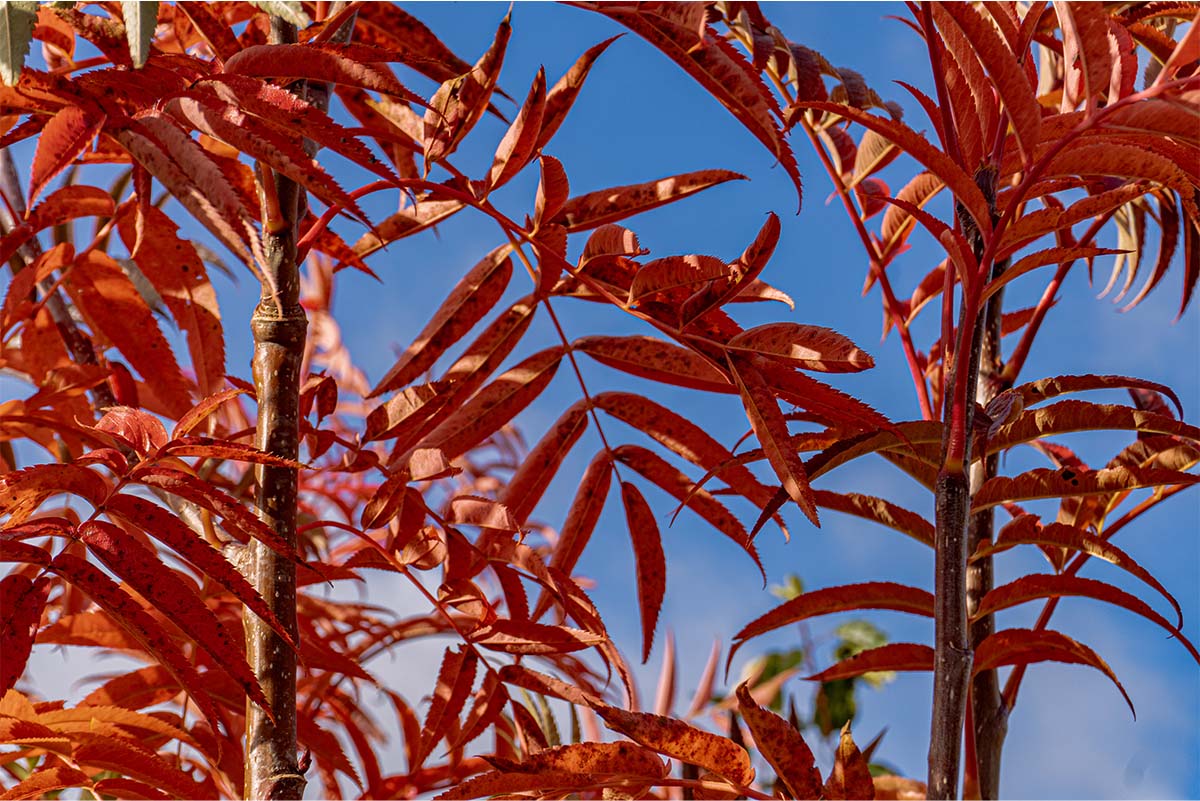
Sorbus commixta ‘Olympic Flame’
Liquidambar styraciflua
Also known as sweetgum, Liquidambar styraciflua is renowned for producing one of the longest-lasting and most varied autumn colour displays in the UK. The leaves of this large deciduous tree turn through a spectrum of red, purple, and orange, often showing multiple colours on the same branch simultaneously. Sweetgum’s star-shaped leaves and pyramidal form provide both architectural interest and seasonal drama, making it an excellent choice for statement planting in parks, large gardens, and avenues. In addition to its ornamental qualities, Liquidambar is tolerant of a range of soils, from clay to loam, and grows best in a sunny to partially shaded position. The tree’s strong structural form, paired with its prolonged and vibrant autumn display, makes it a favourite for designers seeking bold, long-lasting seasonal colour in larger planting schemes.

Liquidambar styraciflua
Sorbus commixta ‘Olympic Flame’
Commonly known as Japanese mountain ash, it has gained popularity in UK landscaping due to its compact size and fiery autumn foliage. The cultivar ‘Olympic Flame’ is particularly valued for its exceptional colour, with leaves turning shades of deep orange and bright red before dropping. Clusters of bright red berries follow the leaf colour, adding winter interest and attracting birds to the garden. Its relatively small stature makes it suitable for courtyards, urban planting, and smaller garden spaces where a dramatic, high-impact tree is desired without overwhelming the site. Beyond its visual appeal, this tree is hardy, tolerant of a range of soil types, and performs well in both sheltered and moderately exposed locations. Its combination of autumnal brilliance, berry display, and manageable size make it a reliable choice for both commercial and residential landscaping.
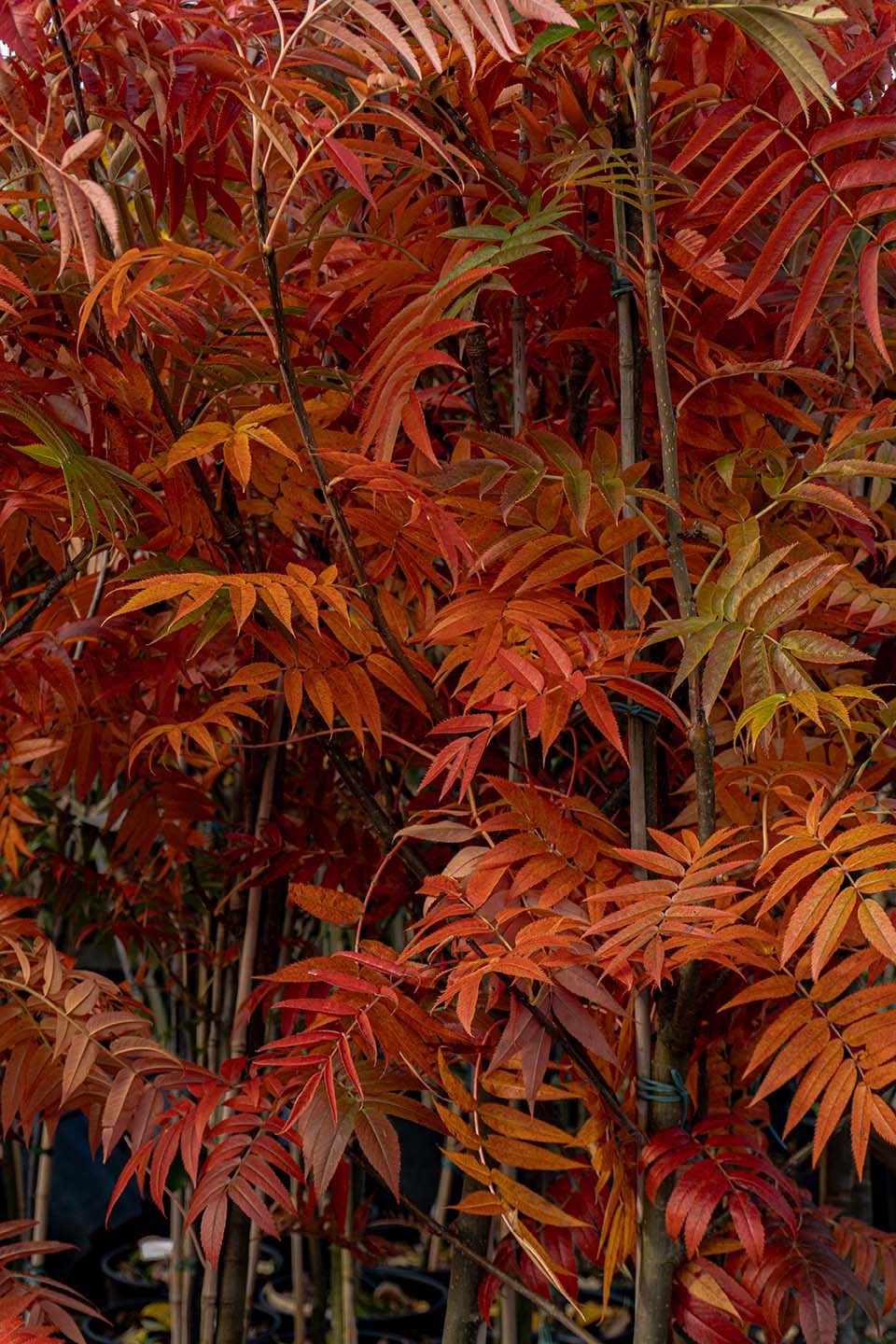
Sorbus commixta ‘Olympic Flame’

Acer platanoides ‘Crimson King’
Acer platanoides ‘Crimson King’
A vigorous and large maple widely planted in urban and parkland settings. Its deep crimson-purple foliage in autumn provides a striking contrast to surrounding greenery, creating visual impact in avenues, open spaces, and public landscapes. The tree’s lobed, glossy leaves retain their rich colour well into the season, ensuring that it stands out even as other trees begin to fade. ‘Crimson King’ is adaptable to a variety of soil types, tolerates pollution, and withstands exposure to wind, making it particularly suitable for city planting schemes. The tree’s strong, upright habit also allows it to function as both a specimen feature and part of structured landscape designs, while its long lifespan ensures ongoing seasonal interest for years to come.
Prunus serrulata
More commonly known as Japanese cherry, it is traditionally celebrated for its spring blossoms, but its autumn foliage provides an equally compelling display. Leaves transition from green to brilliant shades of yellow, orange, and red, adding vibrant seasonal colour to smaller gardens, courtyards, or mixed borders. The medium-sized habit of the tree makes it suitable for locations where larger specimens would be impractical, while its ornamental form contributes architectural interest throughout the year. In addition to autumn colour, the tree’s early-season flowers and attractive branching structure enhance its year-round appeal. Prunus serrulata thrives in well-drained soil with adequate sunlight and benefits from careful placement to protect the leaves from strong winds, which can reduce the longevity of its autumn display.
Fagus sylvatica
European beech produces warm golden tones in autumn that can persist on some trees throughout winter, thanks to their marcescent leaves. Marcescence is the ability of certain varieties of tree to keep their dead leaves on their stems until the new spring buds push through. This adds extended visual interest and definition in the landscape. Beech trees are highly versatile, suitable as specimen trees, hedging, or boundary planting. They perform well in a range of soil types, though they prefer fertile, well-drained conditions. Their dense crowns provide shelter for wildlife, and the combination of autumnal colour with winter structure makes beech an invaluable addition to both formal and naturalistic planting schemes. Its longevity and reliable seasonal interest also mean it continues to provide impact over many decades, reinforcing its status as a cornerstone of UK planting design.
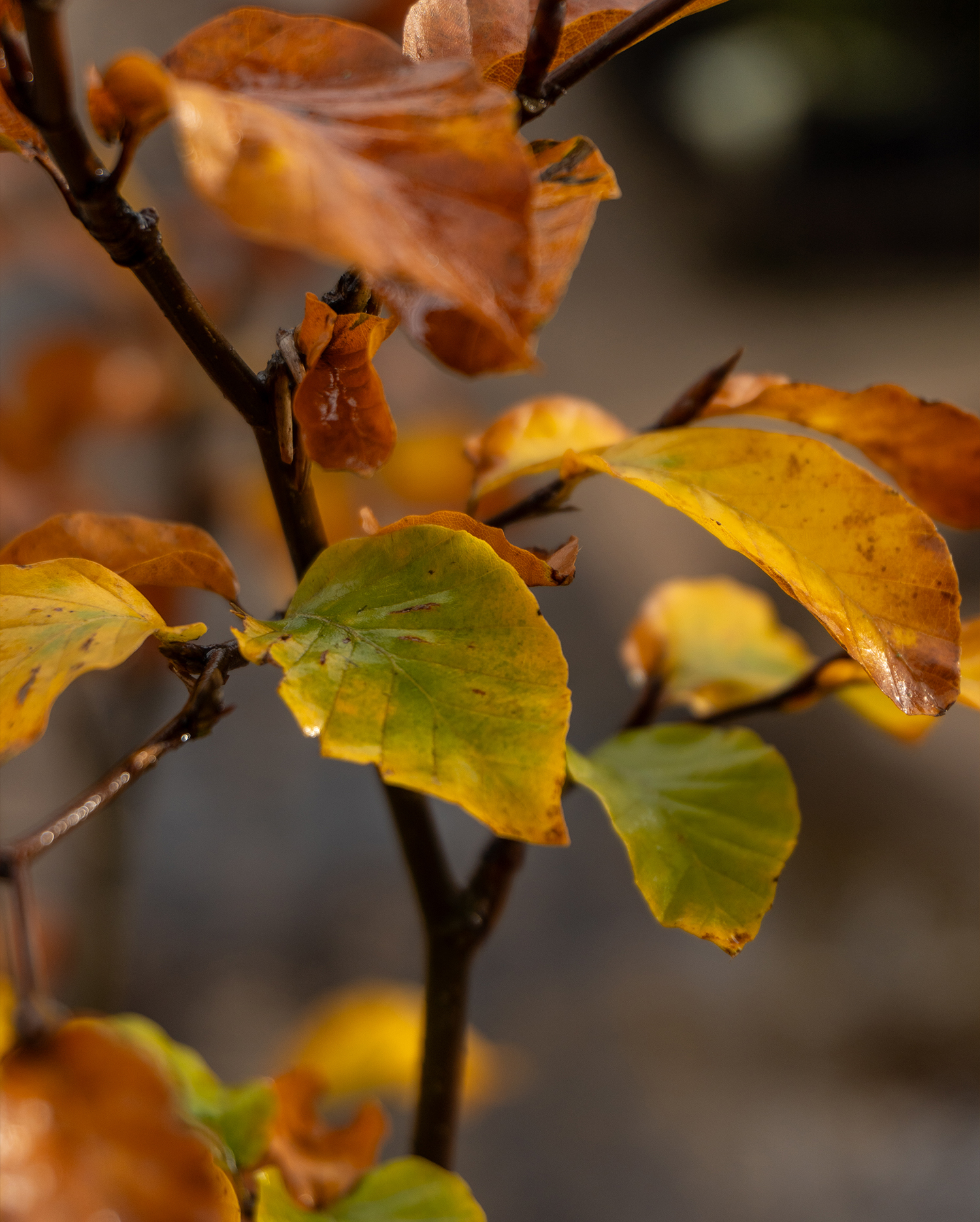
Fagus sylvatica
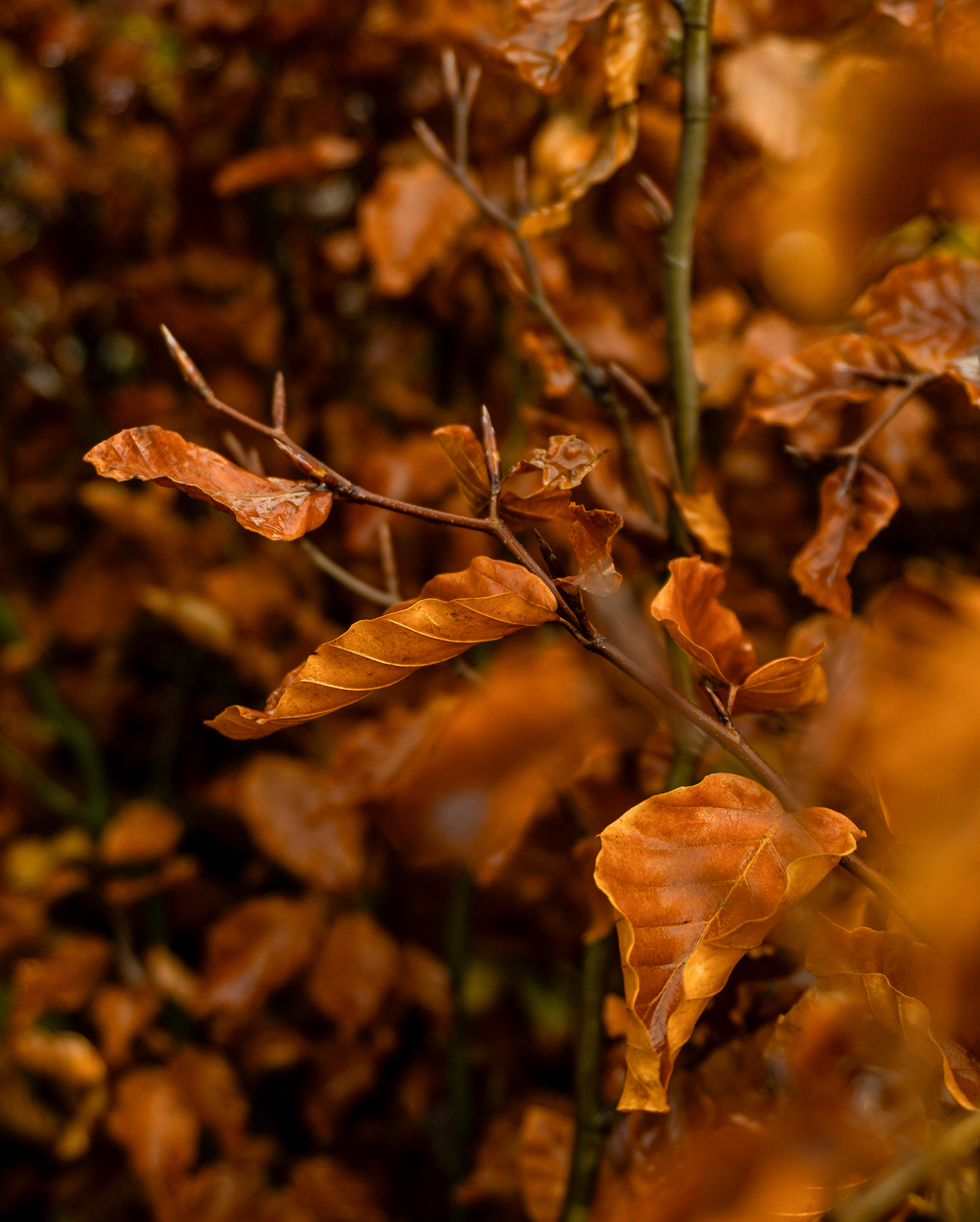
Fagus sylvatica
Acer palmatum
Acer palmatum is a small deciduous tree valued for its finely divided foliage and exceptional autumn colour. Native to Japan, Korea, and China, it brings a delicate, architectural quality to gardens and landscapes. The leaves, typically five- to seven-lobed, emerge in spring in shades of green, red, or bronze before transforming into vivid tones of crimson, orange, and gold in autumn. Preferring sheltered positions with moist, well-drained soil, it thrives in partial shade, where its colours are often most intense. Its compact form makes it ideal for smaller gardens, courtyards, or as a focal specimen in larger landscapes, where its seasonal display provides striking contrast against evergreens or structural planting.
Autumn is a season that can redefine the character of a garden or landscape. By choosing trees with dramatic foliage, designers and landscapers can maintain visual interest late into the year, and create dynamic spaces long after summer has ended.
To learn more about plants for autumn interest, read Planting for year round colour.
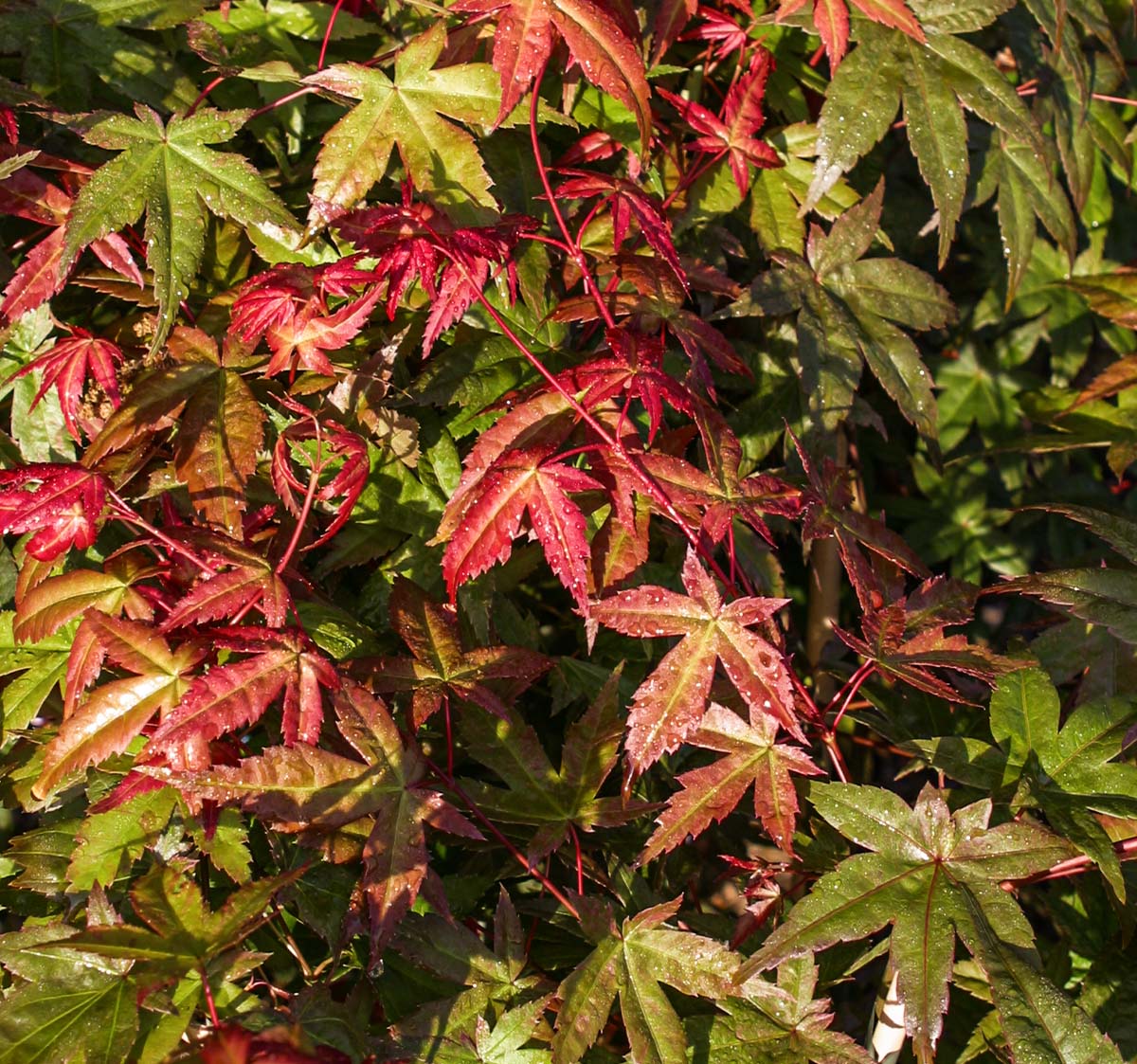
Acer palmatum ‘Chitose-yama’

